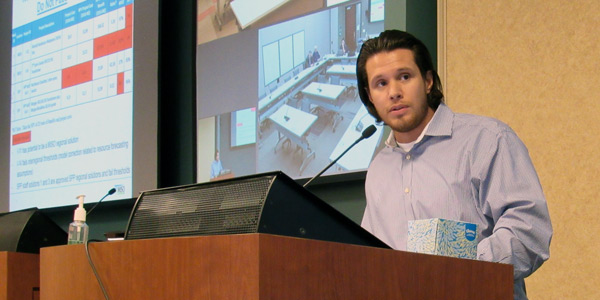By Amanda Durish Cook
MISO is yanking support on the last possible project resulting from a coordinated study with SPP, nixing the RTOs’ chances this year to collaborate on a first-ever interregional project.
The RTO now says an analysis of the $5.2 million Split Rock-Lawrence project in South Dakota shows that congestion on the line can be managed for now and that another alternative project could provide the RTO with at least the same benefit at a lower cost.
MISO originally forecast that the 115-kV circuit project into Sioux Falls would have a 4.79 benefit-cost ratio. The project was the only contender to come out of MISO and SPP’s coordinated system plan study last year, and MISO stakeholders voted in a nonbinding ballot to recommend the project to officials in both RTOs in May. (See MISO-SPP Coordinated Study Yields 1 Possible Project – For Now.)
The project was halted before it could clear the Joint RTO Planning Committee — composed of staff with ultimate say over interregional issues — and before it would have been recommended for inclusion in MISO’s 2017 Transmission Expansion Plan. The coordinated study was meant to focus on needs along the border of SPP’s Integrated System in North Dakota, South Dakota and Iowa. Some MISO stakeholders expressed doubt at the beginning of the study that any projects would materialize.
The RTO said the congested line in South Dakota is now operating as an open circuit under an operations guide proposed by Xcel Energy in May, which shifts some congestion to the nearby Sioux Falls–Split Rock 230-kV line. Had the project — which would have looped Xcel’s existing Split Rock-Lawrence 115-kV circuit into the Western Area Power Administration’s Sioux Falls station, crossing SPP territory — proceeded, Xcel would have been at risk of incurring SPP penalties for unreserved use of non-firm point-to-point transmission service, MISO said.
The RTO recommends the maintaining status quo and operating the Lawrence–Sioux Falls line in an open state to relieve the congestion for now, Davey Lopez, the RTO’s adviser of planning coordination and strategy, said during an Aug. 16 Planning Advisory Committee meeting. He added that the open state operation “provides MISO nearly the same adjusted production cost savings” as the interregional project at little to no cost.
However, MISO said it would continue to pursue upgrades to terminal equipment on the Lawrence–Sioux Falls line through joint efforts between MISO, Xcel, SPP and WAPA. The terminal upgrades would still represent a savings over the originally proposed loop project, the RTO said.
Adam McKinnie, utility economist for the Missouri Public Service Commission, said he had “severe concerns” that MISO was allowing a temporary operations plan to become a long-term solution for congestion.
“We couldn’t justify subjecting our customers to a $5 million project when there’s a no-cost solution available,” Lopez explained.
McKinnie also questioned if the SPP-MISO seam is receiving the same level of interregional coordination as the MISO-PJM seam. “I’m kind of tired of refereeing fights between MISO and SPP because my ratepayers pay for those fights,” he said, adding that SPP officials seem more receptive to interregional planning than those at MISO.
MISO staff countered that the RTO is looking for the most economic and efficient solution to the congestion.
The RTO’s interregional project cost and voltage thresholds with SPP remain unchanged at $5 million and 345 kV, respectively. FERC ruled at the beginning of the year that both RTOs were not bound by its directive to PJM and MISO to remove identical thresholds. SPP had asked FERC last year to apply the same directive to the MISO-SPP seam.
Had the 115-kV Split Rock-Lawrence project won approval, MISO would have had to designate its portion of the project as miscellaneous, unable to qualify for cost allocation, because it does not meet the 345-kV voltage threshold required of its market efficiency projects.
It’s unclear how soon the RTOs will embark on another joint study. Last spring, MISO staff originally decided against a coordinated study, explaining that it was hoping to improve the process behind coordinated studies before taking up another one. Staff later reversed course and agreed to the 2016 coordinated study. A 2014-15 MISO-SPP coordinated study ran over deadline by three months and left both RTO staffs frustrated and empty-handed. (See SPP, MISO Try to Bridge Joint Study Scope Differences.)





